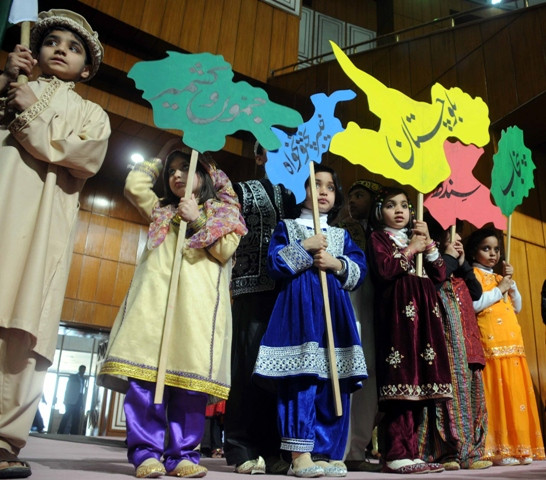My personal view is that many people are demanding division for their petty agendas, but the step is not in the larger interest of Pakistan.
Keeping personal interests aside and treating the matter without bias we have come to the conclusion that:
- Pakistan has certainly developed but not uniformly, many smaller cities have been overlooked (not only in Punjab but in all provinces)
- Facilities are not provided equally to people of all regions
- A lot of potential is being wasted
- The politics of language, colour, and ethnicity are still strong in Pakistan; we have not been able to rise above Punjabi, Pakhtoon, Sindhi or Baloch nationalism
Dividing Punjab on a linguistic basis will add one more nationalism to the above mentioned list - Seraiki - which is destructive for our unity and development. Pakistan has at least 32 languages. Punjabi is spoken by 44% of Pakistan (almost 90 million) and Chitrali is spoken in just one district (less than 0.5 million). A division will not only further divide us as a nation, but will give rise to more politics and hamper economic growth since many linguistic based provinces will not be economically viable.
However, if the provinces are divided in the best interest of Pakistan, many benefits can be achieved:
- More provinces means more cities will be developed and all the population load which is coming into either Karachi or Lahore can be reduced.
- More people will be empowered to choose their destiny.
- There will be a better distribution of resources in Pakistan.
- It may promote Pakistani nationalism - rather than provincial nationalism - if the division is not based on languages.
- It will probably allow politicians to seriously work for their people, once they don't have Big Brother Punjab to blame for everything.
These reasons compelled us to come up with a new (suggested) provincial division for Pakistan. We do not claim to be experts, but have employed common sense and proposed this division in the best interest of our country.
We divided Pakistan into 12 provinces and made Islamabad the federal capital. For the large part, we did not divide the existing districts except for in a few places. Railway links, roads, rivers and canal flows were also considered while we made these proposed changes.
The names of the new provinces are not based on caste, language or any one identity in most cases but on the basis of history and geography. Presently, the names of all the provinces except Sindh do not have much historical connotation.
Critical issues like the Kalabagh Dam are not resolved due to Sindhi-Punjabi politics. Once the new proposed provinces are made, many of these issues will be resolved amicably as the Indus River will not be under the “Takht-e-Lahore” rule. Most of the proposed provinces are linguistically heterogeneous and strongly bonded geographically. Many smaller languages will also have a chance to flourish because majority languages will not overshadow minority languages as they do at present.
Below are the suggested new provinces for Pakistan:

Here are some details about these provinces:
Cholistan province
Capital: Bahawalpur
Linguistic composition: Seraiki, Punjabi, Urdu
Districts: Bahawalpur, Bahawalnagar, Rahim Yar Khan
Current estimated population: 10 million
Reasoning: Geographically on the right side of the Sutlej River and linguistically heterogeneous. Currently, this area is under developed, underutilised and much further from the existing capital Lahore. The new capital, Bahawalpur, will be in the middle of the province and is already linked with the N5 National Highway and main railway line and also has a high court bench.
Ravi province
Capital: Lahore
Linguistic composition: Punjabi, Urdu
Districts: Lahore, Kasur, Okara, Nankana sb, Sheikhupura, Gujranwala, Hafizabad, Sialkot, Narowal, Faisalabad (partly)
Current estimated population: 36.4 Million
Reasoning: It's on the right side of Chenab
Gandhara province
Capital: Joharabad (District Khushab)
Linguistic Composition: Potohari, Seraiki, Punjabi, Pashto,
Districts: Rawalpindi (partly), Jehlum, Attock, Chakwal, Gujrat, Mandi Bahauddin, Sargodha, Khushab, Jhang, Mianwali, Bhakkar, Layyah, DG Khan (partly)
Current estimated population: 24 Million
Reasoning: The underdeveloped western Punjab area would greatly benefit from developing new cities like Joharabad. Joharabad is in the center of the province. On the North of Joharabad is Potohari, on the East is Punjab and on the South are the Seraiki dominant districts. Therefore, the new provincial capital will be the meeting point of all three rich cultures and will be the torch bearer of development and homogeneity for this province. The new capital Joharabad will not face water shortages as river Jehlum passes by it.
Panjnad province
Capital: Multan
Linguistic composition: Seraiki, Punjabi, Urdu, Balochi
Districts: Multan, Lodhran, Khanewal, Sahiwal, Vehari, Pakpattan, Faisalabad (partly), Toba Tek Singh, Muzaffargarh, DG Khan (partly), Rajanpur
Estimated population: 24 million
Reasoning: Multan is already the cultural and political center for southern Punjab. The Panjnad province will become the focus of agriculture and dairy products. Multan is also in the middle of the proposed province and is well connected with near by towns/cities as well as the rest of Pakistan. The proposed Panjnad province will have a significant punjabi province in north eastern districts, urdu in the urban areas, Balochi in western districts & Saraik in central & western districts.
Bolan province
Capital: Quetta
Linguistic composition: Pashto, Balochi, Brahvi
Districts: Quetta, Ziarat, Mastung, Qila Abdullah, Pashin, Lora Lai, Barkhan, Musakhel, Qila Saifullah, Zhob, Shirani, Harnai, Sibi, Kolhu, Dera Bugti, Jaffarabad, Nasirabad, Jhal Magsi, Kacchi (Bolan)
Estimated population: 6 million
Reasoning: The Bolan province will be approximately the same as the British Balochistan of the colonial era. Veteran leaders from Balochistan, like former prime minister Mir Zafar Ullah Khan Jamali and Mehmood Khan Achakzai also once expressed their approval in dividing Balochistan in the Quetta and Kalat division of the 1970s. The heterogenous Bolan province is an amalgamation of the Pashtun, Balochi and Brahvi culture. Quetta has representation from all three cultures.
Makran province
Capital: Khuzdar
Linguistic composition: Balochi and Brahvi
Districts: Khuzdar, Kalat, Noshki, Chaghi, Kharan, Washuk, Panjgor, Turbat, Gawadar, Awaran, Lasbela
Estimated population: 3 million
Reasoning: The Makran province is one of the richest areas of Pakistan due to mineral resources. It also has the Gawadar Port and the Gadani ship breaking yard. Saindak and Rekodek are also located in this province. The proposed provincial capital, Khuzdar, is already well connected with Quetta, Karachi and Larkana through the Regional Cooperation for Development (RCD) road and M8 Motorway. Within the proposed province, all the major cities like Lasbela, Turbat, Gawadar and Kalat are also connected with Khuzdar.
Khyber province
Capital: Peshawar
Linguistic composition: Pashto, Saraiki
Districts: Peshawar, Noshera, Charsadda, Kohat, Karak, Hangu, Lakki Marwat, Bannu, DI Khan, Tank
Estimated population: 9.75 million
Reasoning: The proposed Kalabagh Dam will benefit the southern districts of the proposed Khyber province, Tank and DI Khan at the cost of some land of the Nowshera district. Royalty from the Kalabagh, Munda Dam and also the natural gas resorvoir of Karak will make the province economically viable.
Abaseen province
Capital: Mardan
Linguistic composition: Pashto, Hindko, Kohistani, Chitrali
Districts: Mardan, Sawabi, Haripur, Abottabad, Manshera, Torghar, Batagram, Kohistan, Shangla, Sawat, Bonair, Dir bala, Dir payin, Malakand, Chitral
Estimated population: 13 million
Reasoning: Comprising of the northern areas, this province has the potential to truly boost the tourism industry. The Tarbela and Bhasha Dams will provide substantial revenue for the development of the province and also have high potential to generate hydro-electricity. Mardan is chosen as the capital because it is in the planar district and is accessible all year round from both the Hazara and Malakand divisions.
Khorasan province
Capital: Torkham
Linguistic composition: Pashto
Districts: Bajaur, Mohmand, Torkham (Khyber Agency), Kurram, Orakzai, North waziristan, South Waziristan
Estimated population: 5 million
Reasoning: Making the Federally Administered Tribal Areas (Fata) into a province will start the era of economic growth and amalgamation of the region with the rest of the country. It will also help to remove the sense of depravity among the people.
Sindh Uttar province
Capital: Sukkur
Linguistic composition: Sindhi
Districts: Sukkar, Ghotki, Khairpur, Noshero Feroz, Shikarpur, Larkana, Kambar, Kashmor, Jacobabad, Dadu, Jamshoro (partly)
Estimated population: 13.5 million
Reasoning: Other than Hyderabad, interior Sindh is also one of the most deprived areas of the country; even after having so much potential in various fields, it is backward and underdeveloped. Sukkur is already the economic and cultural center of northern Sindh and has the full potential to become one of the key economic cities of Pakistan. It is also well connected with Karachi, Quetta and northern Pakistan by road, air and railway.
Sindh Dakshin province
Capital: Hyderabad
Linguistic composition: Sindhi, Urdu
Districts: Karachi, Jamshoro (partly), Hyderabad, Matiari, TM Khan, Tando Allah Yar, Mirpur Khas, Umar Kot, Tharparkar, Badin, Thatta, Nawabshah, Sanghar
Estimated population: 26 million.
Reasoning: The third largest city (in 1951) and the historic capital of Sindh in the pre-colonial era, Hyderabad has lost its glory by being overshadowed by Karachi. It is also the convergence point of Sindhi and Urdu culture, the two main cultures of the proposed province. Karachi is overburdened by being the port and also the only industrial city in southern Pakistan. Shifting the capital to Hyderabad will allow it to flourish while also reducing the population inflow in Karachi.
Karakoram Province
Capital: Gilgit
Linguistic composition: Shina, Burushaski, Balti
Districts: Gilgit, Diamir, Astor, Skardu, Hunza-Nagar, Ghanchi, Girghiz,
Estimated population: 1.8 million
Reasoning: Making the present Gilgit-Baltistan a province will give its people the same rights as the rest of Pakistan and start new era of economic and cultural development in the area.
Federal capital: Islamabad and Rawalpindi city
Current estimated population: 2.5 Million
Logic: Rawalpindi city is surrounded by Islamabad from three sides, so making it part of Islamabad is a natural choice.
Here are the benefits of this proposed division:
- The biggest benefit will be the development of new cities. Currently, the population inflow is only in Karachi and some cities of central Punjab. Cities like Multan, Bahawalpur, Sukkur, Hyderabad, Nawabshah, Sahiwal and others may have the potential to become modern cities but remain under developed as the economic growth is polarised in Karachi & central Punjab. By developing new provinces, many cities will have a chance to flourish
- The proposed provinces do not have large population difference that currently exist between Punjab and Balochistan.
- Smaller provinces will help people reach the provincial capital with ease and will also ease management.
This blog was originally published here.



COMMENTS
Comments are moderated and generally will be posted if they are on-topic and not abusive.
For more information, please see our Comments FAQ